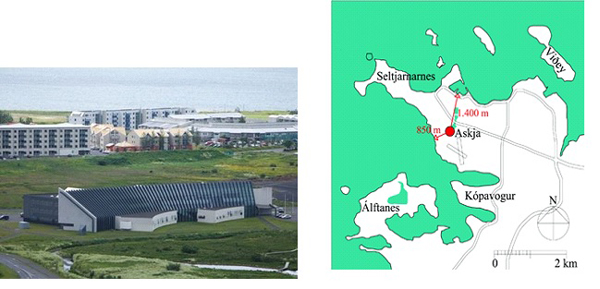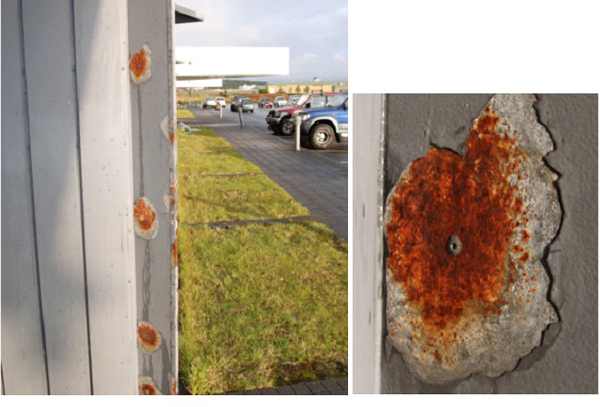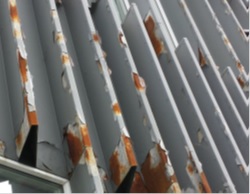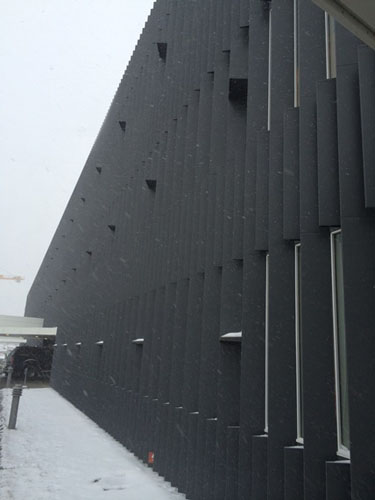- Home
- About Journals
-
Information for Authors/ReviewersEditorial Policies
Publication Fee
Publication Cycle - Process Flowchart
Online Manuscript Submission and Tracking System
Publishing Ethics and Rectitude
Authorship
Author Benefits
Reviewer Guidelines
Guest Editor Guidelines
Peer Review Workflow
Quick Track Option
Copyediting Services
Bentham Open Membership
Bentham Open Advisory Board
Archiving Policies
Fabricating and Stating False Information
Post Publication Discussions and Corrections
Editorial Management
Advertise With Us
Funding Agencies
Rate List
Kudos
General FAQs
Special Fee Waivers and Discounts
- Contact
- Help
- About Us
- Search

The Open Conference Proceedings Journal
(Biological Sciences, Chemical Sciences, Physical Sciences, Medicine, Engineering & Technology)
(Discontinued)
ISSN: 2210-2892 ― Volume 10, 2020
Corrosion of Askja, the Natural Sciences Building in Reykjavik. A Case Study 2004-2014
Ragnheidur Thorarinsdottir*
Abstract
Corrosion problems related to the design, material selection and construction of Askja, the Natural Sciences Building at the University of Iceland have been followed through a period of ten years from 2004.
The building is made of aluzinc cladding with a quite complex structure. All fasteners are of stainless steel. The cladding was painted after construction. The building is close to the centrum of Reykjavik and nearby the coastlines.
In short, the building had already suffered corrosion damage prior to the opening day and these have accelerated. Some parts of the building have been repainted during the period, and during autumn 2014 the whole structure was renovated by polishing and repainting it. However, no changes were made to the design or materials, hence the corrosion problem has not been solved.
Article Information
Identifiers and Pagination:
Year: 2016Volume: 7
First Page: 88
Last Page: 93
Publisher Id: TOPROCJ-7-1-88
DOI: 10.2174/2210289201607010088
Article History:
Received Date: 23/3/2015Revision Received Date: 23/9/2015
Acceptance Date: 25/3/2016
Electronic publication date: 30/04/2016
Collection year: 2016
open-access license: This is an open access article licensed under the terms of the Creative Commons Attribution-Non-Commercial 4.0 International Public License (CC BY-NC 4.0) (https://creativecommons.org/licenses/by-nc/4.0/legalcode), which permits unrestricted, non-commercial use, distribution and reproduction in any medium, provided the work is properly cited.
* Address correspondence to this author at the University of Iceland, Reykjavik, Iceland; Tel:+354-8464830; Email: rith@hi.is
| Open Peer Review Details | |||
|---|---|---|---|
| Manuscript submitted on 23-3-2015 |
Original Manuscript | Corrosion of Askja, the Natural Sciences Building in Reykjavik. A Case Study 2004-2014 | |
INTRODUCTION
The design of Askja, the Natural Sciences Building at the University of Iceland began in 1994. A 7 900 m2 building was designed and the construction began in 1997. The building is situated within the university area nearby the centrum of Reykjavik 850 m and 1 400 m, respectively from the coastlines (see Fig. 1 ) [1Hardarson, Æ. Skemmdir í málmklæðningu, Orsakir (e. Damages in an aluzinc cladding) Report. University of Iceland, 2013. ]. The aluzinc (AZ150) cladding was installed using stainless steel (A4) fasteners during 1999-2000. The cladding was painted after the construction was finished in 2000. The first signs of corrosion problems were detected in early 2002, and in early 2004 at the formal opening of the building the corrosion attacks were already severe.
) [1Hardarson, Æ. Skemmdir í málmklæðningu, Orsakir (e. Damages in an aluzinc cladding) Report. University of Iceland, 2013. ]. The aluzinc (AZ150) cladding was installed using stainless steel (A4) fasteners during 1999-2000. The cladding was painted after the construction was finished in 2000. The first signs of corrosion problems were detected in early 2002, and in early 2004 at the formal opening of the building the corrosion attacks were already severe.
The corrosion of Askja has been followed by engineering students following the Corrosion course VEL501M at the University of Iceland during the last ten years. This article introduces the problem and discusses the main causes for the corrosion and possible future solutions.
OBSERVATIONS
In early 2004 the Natural Sciences Building at the University of Iceland was formally opened. Unfortunately, already at the opening severe corrosion attack was observed in the metal cladding.
The metal cladding of Askja covers large parts of three sides of the building, to the East, South and West. It is a very complex structure with large protruding ridges (see Fig. 2 ). The cladding is made of 1 mm aluzinc (AZ150) fastened together with stainless steel (A4) screws and rivets.
). The cladding is made of 1 mm aluzinc (AZ150) fastened together with stainless steel (A4) screws and rivets.
The average annual precipitation in Reykjavik is 800 mm and the average humidity is 80% [2Icelandic Met Office. Official Statistics, 2015. Available from: www.vedur.is]. The building is close to the coastlines and the city centrum. Therefore, the corrosivity is classified as C4 (high) according to EN ISO 12944-2 [3ISO/DIS 12944-2:1998. Paints and Varnishes -- Corrosion Protection of Steel Structures by Protective Paint Systems -- Part 2: Classification of Environments, 1998. Available at: http://www.iso.org/iso/home/store/catalogue_tc/catalogue_detail.htm?csnumber=64834]. Thus, the choice of aluzinc (AZ150) has been questioned due to the relatively harsh corrosion environment. As alternatives, aluzinc (AZ185) with a coating thickness of 25 μm compared to 20 μm in aluzinc (AZ150) or even
aluminium sheets have been suggested. Aluminium sheets have proved to be durable in this environment. According to Hardarson [1Hardarson, Æ. Skemmdir í málmklæðningu, Orsakir (e. Damages in an aluzinc cladding) Report. University of Iceland, 2013. ] the involved tradesmen suggested changing the cladding material to aluminium and warned against the use of stainless steel fasteners in the aluzinc cladding based on their earlier experience and general existing know-how about galvanic corrosion. Unfortunately, the material selection was not changed from the design.
 |
Fig. (1) The Askja building is situated within the university area in Reykjavik 850 and 1,400 m, respectively from the coastlines [1Hardarson, Æ. Skemmdir í málmklæðningu, Orsakir (e. Damages in an aluzinc cladding) Report. University of Iceland, 2013. ]. |
 |
Fig. (2) The Askja building showing the complex structure with its large protruding ridges. Photo taken in September 2011. |
The quality of the cleaning and painting process was also debated. However, tests carried out by Force Technology in Denmark in 2005 showed generally good adherence of the paint on uncorroded surfaces, and the corrosion attack was found mainly in the areas around the stainless steel fasteners and the plate edges [1Hardarson, Æ. Skemmdir í málmklæðningu, Orsakir (e. Damages in an aluzinc cladding) Report. University of Iceland, 2013. ].
The corrosion problems are mostly observed around the stainless steel fasteners as shown in Fig. (3 ) (photo taken in September 2009) but also close to crevices. Even repainted areas suffer from galvanic corrosion within one year of the repair (see Fig. 4
) (photo taken in September 2009) but also close to crevices. Even repainted areas suffer from galvanic corrosion within one year of the repair (see Fig. 4 ). Thus, the main corrosion cause is related to galvanic corrosion driven by the large difference in the corrosion potential between the stainless steel and the aluzinc. Secondly, the structure is complex, with narrow gaps between surfaces allowing retention of water and pollution and thereby promoting crevice corrosion. In this case the crevice corrosion is compounded by galvanic effects. Fig. (5
). Thus, the main corrosion cause is related to galvanic corrosion driven by the large difference in the corrosion potential between the stainless steel and the aluzinc. Secondly, the structure is complex, with narrow gaps between surfaces allowing retention of water and pollution and thereby promoting crevice corrosion. In this case the crevice corrosion is compounded by galvanic effects. Fig. (5 ) shows the corroded building in September 2013.
) shows the corroded building in September 2013.
It has also been pointed out that the surface cleaning and painting was not done according to the the specifications. However, the paint has shown good adhesion in areas not affected by the stainless steel fasteners or crevices.
 |
Fig. (3) The corrosion attack related to the stainless steel fasteners. Photos from September 2009 [4Gudmundsson, O. Tæring á háskólabyggingunni Öskju (e. Corrosion at the university building Askja); Report in VÉL501M Corrosion: Autumn. University of Iceland, 2009. ]. |
 |
Fig. (4) Galvanic corrosion of a repainted part of Askja building in September 2013. |
Askja has been renovated during the last year by polishing the cladding and repainting it (see Fig. 6 ). Alternative solutions providing a future solution to the corrosion problem were also discussed and estimated. This included redesigning the cladding with a simpler design and renewing it using aluminium. However, this would involve a high cost and moreover, approval would be needed from the building's architect [1Hardarson, Æ. Skemmdir í málmklæðningu, Orsakir (e. Damages in an aluzinc cladding) Report. University of Iceland, 2013. ]. Thus, the problem has hardly been solved with the recent renovation of the building, and the galvanic corrosion between the aluzinc cladding and the stainless steel fasteners will continue. Corrosion products can already be detected in a few places around stainless steel fasteners. The complex structure with the many crevices, together with the weather conditions and the closeness to the coast, further accelerates the corrosion.
). Alternative solutions providing a future solution to the corrosion problem were also discussed and estimated. This included redesigning the cladding with a simpler design and renewing it using aluminium. However, this would involve a high cost and moreover, approval would be needed from the building's architect [1Hardarson, Æ. Skemmdir í málmklæðningu, Orsakir (e. Damages in an aluzinc cladding) Report. University of Iceland, 2013. ]. Thus, the problem has hardly been solved with the recent renovation of the building, and the galvanic corrosion between the aluzinc cladding and the stainless steel fasteners will continue. Corrosion products can already be detected in a few places around stainless steel fasteners. The complex structure with the many crevices, together with the weather conditions and the closeness to the coast, further accelerates the corrosion.
DISCUSSION
The corrosion of Askja is the consequence of several mistakes in the design and construction of the aluzinc cladding.
 |
Fig. (5) Corrosion attack on Askja building in September 2013. |
 |
Fig. (6) Askja in February 2015, after renovation. |
First of all, the use of stainless steel fasteners in the aluzinc cladding has led to severe galvanic corrosion of the aluzinc adjacent to the fasteners. That using stainless steel fasteners in contact with aluzinc leads to severe galvanic attack in corrosive environments is well known [5Misiek, T.; Käpplein, S.; Ulbrich, D. Selecting Materials for Fastening Screws for Metal Members and Sheeting (Report). Steel Construction, 2013, (1), 39-46.].
Secondly, the design of the complex structure promotes crevice corrosion. The oxygen deficiency and retention of moisture in crevices between sheets, and between fasteners and sheets, forms aeration cells, accelerating local corrosion attacks. This is further promoted by chlorides and other pollution particles that get drawn into the crevices to balance the positive charge of metal cations created by corrosion. The pollution particles stay in the crevices and become more concentrated and more aggressive over time [6Jones, D.A. Principles and Prevention of Corrosion, 2nd ed.; Prentice Hall Inc.: Upper Saddle River, NJ 07458, USA, 1992. ].
Thirdly, the corrosivity category, according to EN ISO 12944-2 [3ISO/DIS 12944-2:1998. Paints and Varnishes -- Corrosion Protection of Steel Structures by Protective Paint Systems -- Part 2: Classification of Environments, 1998. Available at: http://www.iso.org/iso/home/store/catalogue_tc/catalogue_detail.htm?csnumber=64834], has been estimated to be C4 (high), industrial areas and coastal areas with moderate salinity. The building is situated relatively close to the coasts. This corrosivity level does not support the use of aluzinc-coated (AZ150) steel sheet, according to EN1993-1-3 [7EN 1993-1-3:2006. Design of Steel Structures - Part 1-3: General Rules - Supplementary Rules for Cold-Formed Members and Sheeting, CEN:Brussels 2006. Available at: https://law.resource.org/pub/eu/eurocode/en.1993] and EN1999-1-4 [8EN 1999-1-:2007. Design of Aluminium Structures - Part 1-4: Cold-Formed Structural Sheeting, CEN:Brussels 2007. Available at: https://law.resource.org/pub/eu/eurocode/en.1999]. Thus, the aluzinc sheets will also suffer from uniform atmospheric corrosion. Instead AZ185 with a thicker coating or alternatively, aluminium, hot dip zinc coated plus organic coated or stainless steel should be used.
The repainting of the building without changing the stainless steel fasteners or isolating them from the aluzinc cladding will not last for a long time. Corrosion attacks can already be seen some places one year after the renovation. Due to the complex design and number of fasteners it is costly and difficult to change all the fasteners. In the future it will become necessary to replace the cladding and use fasteners of similar material, preferably aluminium as this has worked well in similar environment. This needs to be done before the corrosion becomes so severe that the cladding begins to fall off damaging properties, injuring or even killing people. It would also be preferable to simplify the design to reduce the susceptibility towards crevice corrosion.
CONCLUSION
The design and material selection for the Askja building did not take into account the corrosivity of the environment. Especially, the choice of fasteners with a much higher corrosion potential than the cladding itself led to galvanic corrosion. In addition, the many crevices of the cladding promote local corrosion attack. Moreover, a cladding material known to suit better the environmental conditions should have been chosen.
The unfortunate damage on Askja has been extremely costly, and shows how fundamental, well known mistakes still find their way through design, acceptance and construction, in spite of all the regulatory steps and review by building committees. Even warnings from experienced tradesmen, that could have prevented the mistakes, were not taken into consideration. Moreover, it can even be legally complicated and expensive to rectify the problem, and the recent renovation of the building does not prevent continued corrosion. Thus, the corrosion will carry on and the appearance will be spoiled again. Ultimately, the corrosion attack may lead to failure of the connection between the sheets and the fasteners if the cladding is not replaced resulting in hazardous circumstances for properties and people.
CONFLICT OF INTEREST
The author confirms that this article content has no conflict of interest.
ACKNOWLEDGEMENTS
Askja has offered an excellent corrosion case study at campus for engineering students attending the course Corrosion VEL501M at the Faculty of Industrial Engineering, Mechanical Engineering and Computer Science at the University of Iceland during the last ten years. Thus, I would like to thank the students for their excellent reports. Also, the people at the Divsion of Operations and Resources at the University of Iceland are sincerely thanked for sharing information regarding the problems at Askja.
REFERENCES
| [1] | Hardarson, Æ. Skemmdir í málmklæðningu, Orsakir (e. Damages in an aluzinc cladding) Report. University of Iceland, 2013. |
| [2] | Icelandic Met Office. Official Statistics, 2015. Available from: www.vedur.is |
| [3] | ISO/DIS 12944-2:1998. Paints and Varnishes -- Corrosion Protection of Steel Structures by Protective Paint Systems -- Part 2: Classification of Environments, 1998. Available at: http://www.iso.org/iso/home/store/catalogue_tc/catalogue_detail.htm?csnumber=64834 |
| [4] | Gudmundsson, O. Tæring á háskólabyggingunni Öskju (e. Corrosion at the university building Askja); Report in VÉL501M Corrosion: Autumn. University of Iceland, 2009. |
| [5] | Misiek, T.; Käpplein, S.; Ulbrich, D. Selecting Materials for Fastening Screws for Metal Members and Sheeting (Report). Steel Construction, 2013, (1), 39-46. |
| [6] | Jones, D.A. Principles and Prevention of Corrosion, 2nd ed.; Prentice Hall Inc.: Upper Saddle River, NJ 07458, USA, 1992. |
| [7] | EN 1993-1-3:2006. Design of Steel Structures - Part 1-3: General Rules - Supplementary Rules for Cold-Formed Members and Sheeting, CEN:Brussels 2006. Available at: https://law.resource.org/pub/eu/eurocode/en.1993 |
| [8] | EN 1999-1-:2007. Design of Aluminium Structures - Part 1-4: Cold-Formed Structural Sheeting, CEN:Brussels 2007. Available at: https://law.resource.org/pub/eu/eurocode/en.1999 |



